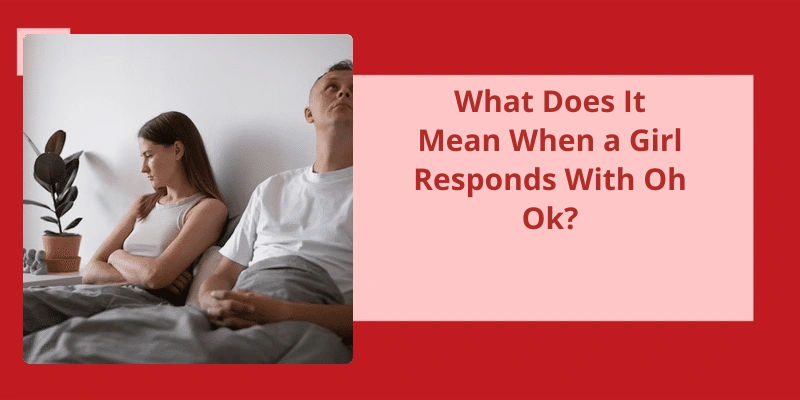When it comes to interpersonal communication, sometimes the words we choose to use can have a much bigger impact than we realize. One such phrase that’s become increasingly common in modern conversation is "Oh okay." While it may seem like a simple and harmless response on the surface, it can often carry a deeper meaning depending on the context and tone in which it’s used. For women in particular, hearing this phrase from someone else can often leave them feeling confused or uncertain about the conversation at hand. In this article, we will explore the various nuances and potential implications of the phrase "Oh okay" in different scenarios, and what it might really mean when a girl responds with this seemingly innocuous reply.
What Do Girls Mean When They Say Ok?
It’s important to remember that communication is complex. Girls (and people in general) don’t always communicate in a straightforward way, and it’s easy to misinterpret what someone means when they say “okay” over text. However, it’s important not to jump to conclusions or overthink the situation when a girl texts you “okay.”
It doesn’t necessarily mean that she’s upset or annoyed with you, although it’s always possible that there’s a deeper meaning behind her response. You should read the context of the conversation and her tone to determine whether there’s something more to her response than a simple agreement.
It’s also important not to assume that a girl is “ghosting” you or trying to end the conversation when she texts you “okay.”. Some people are simply more concise in their texting style, and may not engage in lengthy conversations via text. If you feel like there’s a natural conclusion to the conversation, it’s okay to end things there. Just remember to be polite and respectful, and don’t take her response as a personal affront.
Finally, it’s worth noting that communication is a two-way street. If you want to avoid confusion and misinterpretation when texting with a girl, it’s important to be clear and concise in your own messages. Dont assume that she knows what youre thinking or feeling; if you’ve something important to communicate, take the time to express it clearly and respectfully. By communicating openly and honestly, you can avoid a lot of the confusion and anxiety that often comes with texting.
How to Interpret Other Common Text Responses From Girls Beyond “Okay”
- “I’m fine”: She’s probably not actually fine. This response is often used when someone is feeling upset or down, but doesn’t want to talk about it.
- “Not much, you?”: This is a common response to the question, “What’s up?” It’s usually just a polite way of starting a conversation and showing interest in the other person.
- “I’m busy”: Depending on the context, this could mean anything from “I actually have a lot of work to do” to “I’m not interested in hanging out with you.”
- “Maybe some other time”: This could mean that she’s genuinely busy and can’t make plans right now, or it could be a polite way of rejecting your invitation without hurting your feelings.
- “I don’t know”: This response could mean that she genuinely doesn’t know the answer to your question, or it could be a way of avoiding giving a direct response.
Now that we understand what “oh okay” means, let’s explore some different ways to write it. It may seem like a simple phrase, but there are actually several variations that you can use depending on the situation. Whether you’re sending a text message, chatting with friends, or writing a business email, it’s important to choose the right words to convey your message effectively. Let’s take a closer look at how you can write “oh okay” to express your understanding or agreement.
How Do You Write Oh Okay?
When it comes to writing “oh okay,” there are a few things to keep in mind in order to properly convey the intended message. First and foremost, it’s important to note that the tone of the phrase can vary greatly depending on the context in which it’s used. For example, if someone shares some disappointing or disheartening news, responding with a simple “oh okay” could come across as dismissive or uncaring. On the other hand, if someone is explaining something to you and you respond with “oh okay,” it can be a way of demonstrating that youre actively listening and following along with what theyre saying.
When writing “oh okay,” it’s also important to consider other factors such as punctuation and capitalization. While the phrase itself doesn’t typically require any punctuation, you may choose to include a period or exclamation point depending on the situation. Similarly, capitalizing the words can help emphasize the tone and convey a sense of sincerity and understanding.
In some cases, it may be more appropriate to add additional language or context to ensure that your message is received in the way you intended.
By considering the other persons perspective and adjusting your message accordingly, you can effectively convey your understanding and agreement without coming across as dismissive or disengaged. Whether youre communicating with friends, family, or coworkers, taking the time to craft a thoughtful and considerate response can go a long way in building strong and positive relationships.
Source: Oh! Okay.
In conversations with girls, the phrase “oh okay” can have different meanings depending on the context and tone of voice. It’s important to pay attention to non-verbal cues, as well as the words themselves, to fully understand what’s being conveyed. Let’s explore some common scenarios where the phrase might be used.
What Does Oh OK Mean From a Girl?
For girls, the phrase is used in a variety of contexts and can have different meanings depending on the situation. It can be used to acknowledge that a statement or request has been heard, that a decision has been made, or that a conversation has ended. As a result, it can be difficult to gauge exactly what a girl means when she uses the phrase.
In some cases, “oh okay” may be a neutral response indicating that a girl has no particular opinion on a topic. It could be that she simply doesn’t have enough information to offer an opinion or that she’s trying to remain neutral in a situation where she doesn’t want to take sides. In other cases, it may be a way for a girl to signal that she’s unhappy or disappointed about something but doesn’t want to escalate the situation by expressing those feelings more directly.
Ultimately, the phrase is commonly used in everyday conversation, and while it may seem like a minor comment, it can provide important insights into a girls thoughts and feelings. When responding to it, it’s important to do so in a way that shows you’re listening and willing to continue the conversation, even if it’s reached a bit of a lull. By doing so, you can help to build stronger relationships with the girls in your life and deepen your understanding of their unique perspectives and points of view.
Common Misinterpretations of “Oh Okay” From a Girl
This article discusses some common misunderstandings that can occur when a girl says “oh okay.” It’s important to understand that depending on the context and tone of the conversation, “oh okay” can have a variety of meanings. For example, it could be a polite way of ending a conversation or a dismissive response indicating disinterest. Therefore, it’s important to pay attention to other nonverbal cues and the overall context of the conversation to accurately interpret the meaning behind “oh okay.”
What Does It Mean When a Girl Says It’s OK?
However, the context in which the word “OK” is used can also provide additional information. For example, if the woman seems hesitant or uncertain when saying “OK,” it may indicate that she isn’t fully comfortable with the situation or decision being discussed. On the other hand, if she says “OK” with enthusiasm or excitement, it may indicate that she’s very pleased with the outcome.
It’s important to remember that communication is a complex process, and that there are many nonverbal cues and contextual factors that can influence the meaning behind someones words. Similarly, if she says “OK” in a sarcastic or dismissive tone, it may indicate that she isn’t actually in agreement with what was said.
Ultimately, the best way to understand what someone means when they say “OK” is to pay close attention to their tone of voice, body language, and the context in which the word is used. By doing so, you can gain a more nuanced understanding of their thoughts and feelings, and respond accordingly.
In some cases, it may be helpful to ask for clarification or more information to ensure that you fully understand what the other person is trying to communicate. This can help to prevent misunderstandings and ensure that both parties are on the same page.
How Trust and Relationship History Can Influence How We Interpret Someone Saying “OK.”
- Our past history with an individual can affect how we interpret their use of “OK.”
- If we trust and have a good relationship with someone, we’re more likely to interpret “OK” positively.
- Conversely, if we’ve a strained relationship or don’t trust the person, we may interpret “OK” negatively.
- Nonverbal cues and tone of voice can also impact our interpretation of “OK.”
- It’s important to consider context and the individual when interpreting their use of “OK.”
Now that we understand the meaning and origin of the word “OK,” let’s take a closer look at how and when to use it in texting.
What Does OK Mean in Texting?
The origin of the term OK is actually shrouded in mystery, with several theories floating around about how it came to be. One popular explanation is that it comes from a misspelling of “all correct” as “oll korrect” in 19th century America. Another theory is that it comes from the Choctaw word “okeh” meaning “it is so”. Regardless of it’s origin, OK has become one of the most popular and widely used words in modern communication.
In the world of texting and messaging, OK has taken on an even more important role. It’s frequently used to signify agreement or acceptance, particularly in situations where a quick response is necessary. For example, if someone asks if youre free for dinner tonight, a simple “OK” response indicates that youre available and willing to meet up. Similarly, in a work context, if you receive an instruction from your boss, responding with “OK” shows that you understand and will comply.
Whether youre texting a friend or responding to an important work email, it’s important to use OK appropriately to convey the right message and tone. By understanding it’s origins and nuances, you can better navigate the world of messaging and ensure that your messages are clear, effective, and respectful.
Different Ways of Using OK in Texting (e.g. As a Filler Word, to Indicate Sarcasm or Indifference, Etc.)
OK is a versatile term commonly used in online messaging. It can serve as a filler word or an indicator of agreement. It can also be used sarcastically or to convey apathy or indifference.
Conclusion
For example, if a girl responds with "oh okay" after being told of a change in plans, it may indicate disappointment or hesitation. On the other hand, if she responds with "oh okay" after being complimented, it could indicate gratitude or satisfaction. It’s important to pay attention to the tone and context of the conversation to fully understand the meaning behind a girl's response of "oh okay." Ultimately, communication is a complex and nuanced aspect of human interaction, and one must strive to not only understand the words being spoken, but the emotions and intentions behind them as well.






